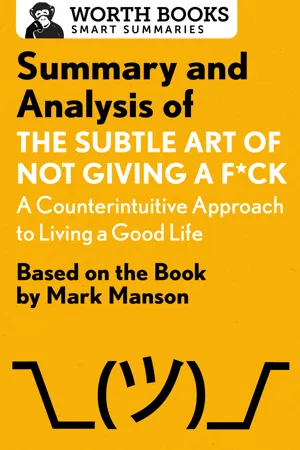Summary
Chapter 1: Don’t Try
Manson explains what he means by “not giving a fuck,” and he clarifies the book’s purpose. “Not giving a fuck” isn’t about not caring about anything—that would make you a psychopath or an insecure poseur—rather, his challenge to the reader is to think much more carefully about the things the reader actually should care about (or, in Manson-speak, give a fuck about). Manson observes that each of us is constantly bombarded with images of success: a huge home in a trendy city, professional success, a hot spouse, a cool car, a perfect lawn, an envy-stoking Facebook personality, and so on. When we take in these images, we feel bad about ourselves, because they remind us of our own perceived deficiencies. On top of this, conventional self-help says that if we just stay positive and believe in ourselves (and other irritating platitudes) everything will work itself out: We’ll be rich, famous, married, ripped, respected, and adored by children everywhere.
Not so, says Manson. The more we try to psych ourselves up artificially, the worse off we’ll actually be. It’s much more productive to be okay with feeling bad about certain things—and then let the feeling go. There’s such a stigma, at least in traditional self-help, about “accepting negativity” (otherwise known as facing the truth), but by giving ourselves permission to admit that something sucks and then move on—in Manson’s words, to take the view “I feel like shit, but who gives a fuck?”—the objects of our unrealistic desire lose some of their power. We care less about them.
The fact that we feel bad about so many things shows that we give too many fucks about too many things. Better, then, to accept our disappointments and focus our time and energy on things we can do. To not give a fuck is to accept our circumstances and our lives. It doesn’t mean that we’ve given up or that we shouldn’t try to improve our station; it simply means that just because we don’t have the best car, the most fulfilling job, or the most Instagram-worthy party pictures, our lives aren’t complete failures. When we give fewer fucks about achieving wildly unrealistic and unlikely goals, we free ourselves from our own exhausting expectations. And, ironically, the peace we gain from this process will provide more clarity. It will show us which things we should truly give a fuck about.
Need to Know: “Not giving a fuck” is about letting go of the stuff you can’t control. Focusing your concern (fucks) on things that you can do, no matter how small, is much more productive.
Chapter 2: Happiness Is a Problem
Here, Manson argues against popular conceptions of happiness. He opens the chapter with an instructive story about the Buddha’s life and his insights. The Buddha (who was a real-life figure) grew up in a palace where all of his needs were met and everything was always harmonious and beautiful. One day, however, he decided to leave the palace and explore the outside world. He was absolutely shocked to see people suffering, a state of being that had been hidden from him all of his life. The experience was unsettling to say the least. He left his family, never to return, in search of life’s meaning. He tried living in abject poverty for a while, but that didn’t teach him much—except that living in abject poverty really, really sucks, and that doing it voluntarily, for no greater purpose, is silly. After some time, he came to a realization (one of the central tenets of Buddhism): “Life itself is a form of suffering.” This is true for everyone, no matter his or her circumstances. The important corollary is that “pain and loss are inevitable and we should let go of trying to resist them.”
Here’s how resistance looks in the real world: For many people, “happiness” has a definable endpoint. They believe “that happiness is algorithmic, that it can be worked for and earned and achieved as if it were getting accepted...
